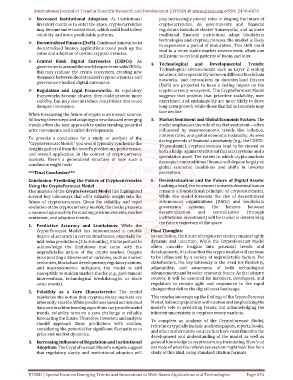Page 684 - Emerging Trends and Innovations in Web-Based Applications and Technologies
P. 684
International Journal of Trend in Scientific Research and Development (IJTSRD) @ www.ijtsrd.com eISSN: 2456-6470
Increased Institutional Adoption: As institutional play increasingly pivotal roles in shaping the future of
investors continue to enter the space, cryptocurrencies cryptocurrencies. As governments and financial
may become more mainstream, which could lead to less regulators introduce clearer frameworks, and as more
volatility and more predictable patterns. traditional financial institutions adopt blockchain
technologies and cryptocurrencies, the market is likely
Decentralized Finance (DeFi): Continued innovation in
to experience a period of maturation. This shift could
decentralized finance applications could push up the
lead to a more stable market environment, albeit one
value and adoption of certain cryptocurrencies.
still prone to cyclical patterns of boom and bust.
Central Bank Digital Currencies (CBDCs): As 4. Technological and Developmental Trends:
governments around the world experiment with CBDCs, Technological advancements such as Layer 2 scaling
this may reshape the crypto ecosystem, creating new solutions, interoperability between different blockchain
dynamics between decentralized cryptocurrencies and networks, and innovations in decentralized finance
government-backed digital currencies.
(DeFi) are projected to have a lasting impact on the
Regulation and Legal Frameworks: As regulatory cryptocurrency ecosystem. The CryptoForecast Model
frameworks become clearer, they could provide more suggests that projects that prioritize scalability, user
stability, but may also introduce restrictions that could experience, and sustainability are more likely to drive
dampen innovation. long-term growth, while those that fail to innovate may
face decline.
While forecasting the future of crypto is an inexact science,
following these steps and adapting to new data and emerging 5. Market Sentiment and Global Economic Factors: The
trends offers the best approach to understanding potential model emphasizes the role of market sentiment—often
price movements and market developments. influenced by macroeconomic trends like inflation,
interest rates, and global economic instability. As seen
To provide a conclusion for a study or analysis of the during periods of financial uncertainty (e.g., the COVID-
"CryptoForecast Model," you would typically synthesize the
19 pandemic), cryptocurrencies tend to be viewed as
insights gathered from the model's predictions, performance,
both a hedge against traditional financial systems and a
and overall application in the context of cryptocurrency
speculative asset. The extent to which crypto markets
markets. Here's a generalized structure of how such a
decouple from traditional finance will depend largely on
conclusion might look:
global economic conditions and shifts in investor
***Final Conclusion*** perception.
Conclusion: Predicting the Future of Cryptocurrencies 6. Decentralization and the Future of Digital Assets:
Using the CryptoForecast Model Looking ahead, the movement towards decentralization
The analysis of the CryptoForecast Model has highlighted remains a foundational principle of cryptocurrencies.
several key takeaways that offer valuable insight into the While the model forecasts the rise of decentralized
future of cryptocurrencies. Given the volatility and rapid autonomous organizations (DAOs) and blockchain
evolution of the cryptocurrency market, the model presents governance systems, the balance between
a nuanced approach to forecasting price movements, market decentralization and centralization (through
sentiment, and adoption trends. institutional investment) will be crucial in determining
the future trajectory of the space.
1. Predictive Accuracy and Limitations: While the
CryptoForecast Model has demonstrated a notable Final Thoughts:
degree of accuracy in certain timeframes, especially for In conclusion, the future of cryptocurrencies remains highly
mid-term predictions (3 to 6 months), it is important to dynamic and uncertain. While the CryptoForecast Model
acknowledge the limitations that come with the offers valuable insights into potential trends and
unpredictable nature of the crypto market. Despite developments, it is clear that the crypto market will continue
incorporating a diverse set of variables, such as market to be influenced by a variety of unpredictable factors. For
sentiment, blockchain developments, regulatory actions, stakeholders, the key takeaway is the need for flexibility,
and macroeconomic indicators, the model is still adaptability, and awareness of both technological
susceptible to sudden market shocks (e.g., government advancements and broader economic forces. As the industry
interventions, technological breakthroughs, or black evolves, it will be essential for investors, developers, and
swan events). regulators to remain agile and responsive to the rapid
changes that define the digital asset landscape.
2. Volatility as a Core Characteristic: The model
reinforces the notion that cryptocurrency markets are This conclusion wraps up the findings of the CryptoForecast
inherently volatile. While predictions based on historical Model, balancing optimism with caution and emphasizing the
data and machine learning algorithms can provide useful model's role in predicting trends, but acknowledging the
trends, volatility remains a core challenge in reliably inherent uncertainty in cryptocurrency markets.
forecasting the future. Therefore, investors and analysts
To complete an analysis of the CryptoForecast Model,
should approach these predictions with caution,
references typically include academic papers, reports, books,
considering the potential for significant fluctuations in
and other authoritative sources that have contributed to the
price and market dynamics.
development and understanding of the model, as well as
3. Increasing Influence of Regulation and Institutional general knowledge in cryptocurrency forecasting. Here's an
Adoption: The CryptoForecast Model's outputs suggest example of what the references section might look like for a
that regulatory clarity and institutional adoption will study of this kind, using standard citation formats:
IJTSRD | Special Issue on Emerging Trends and Innovations in Web-Based Applications and Technologies Page 674

